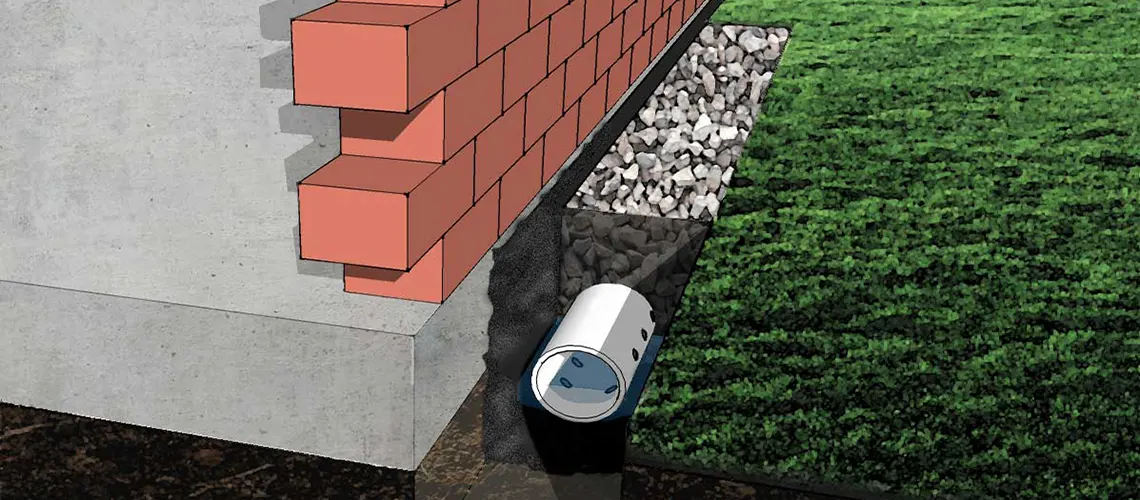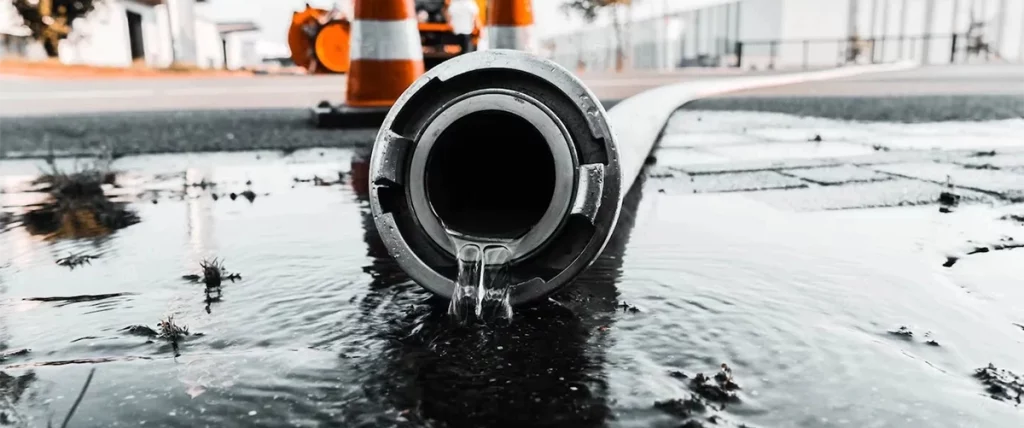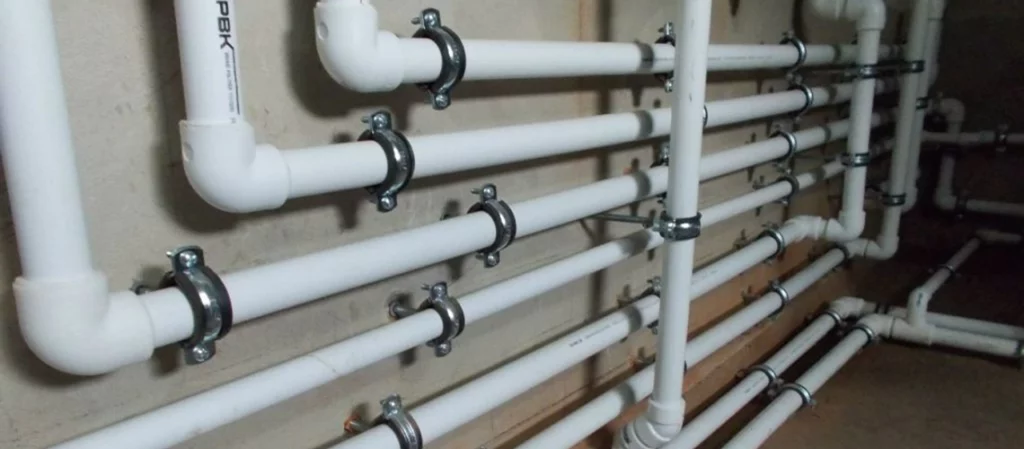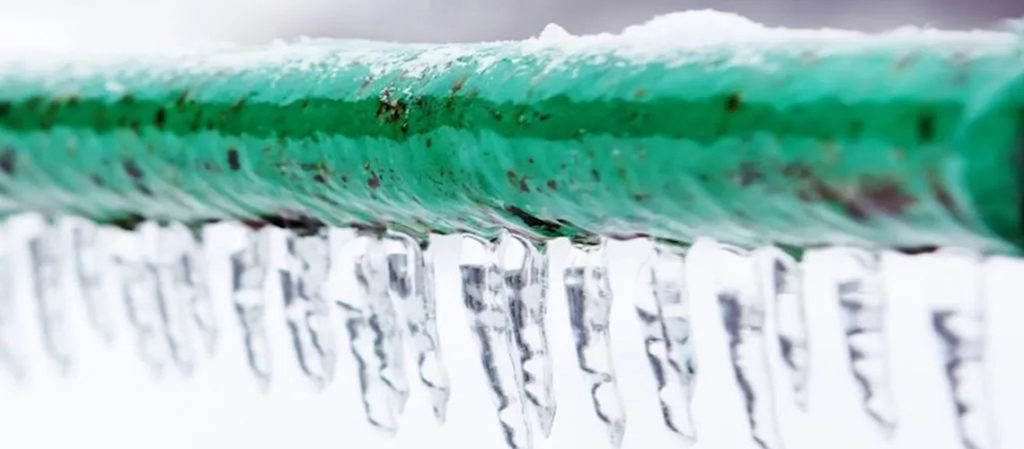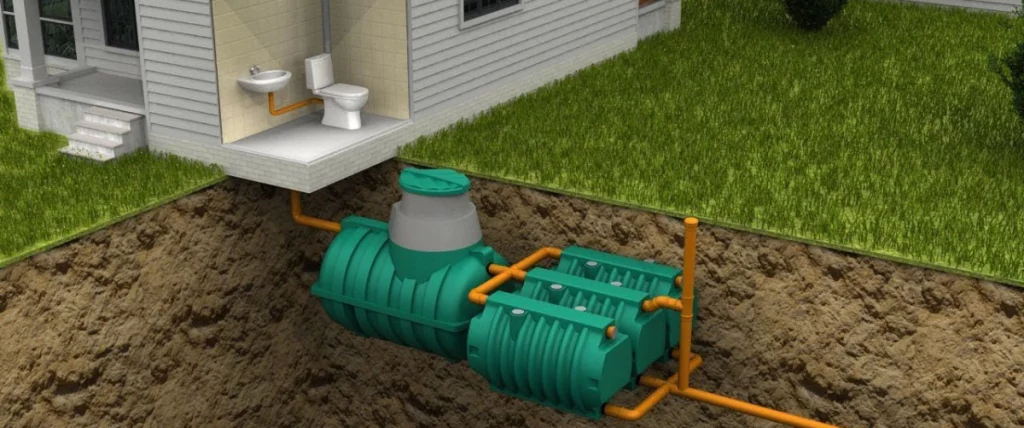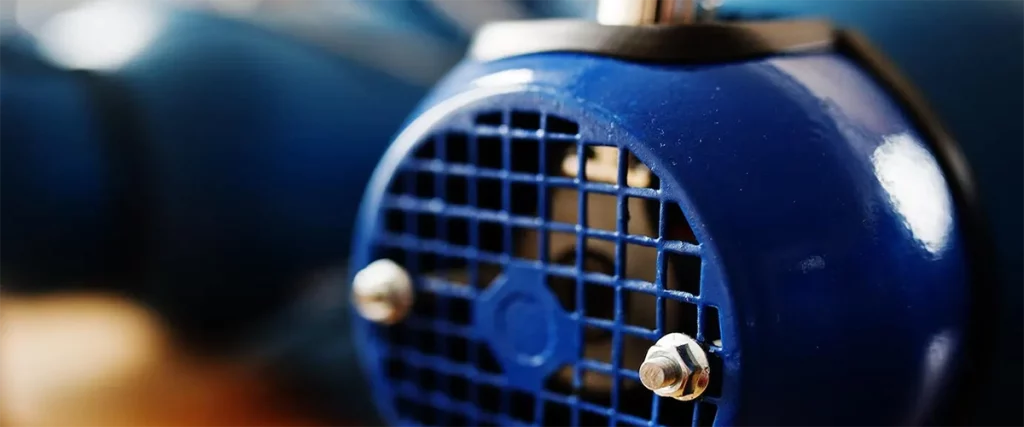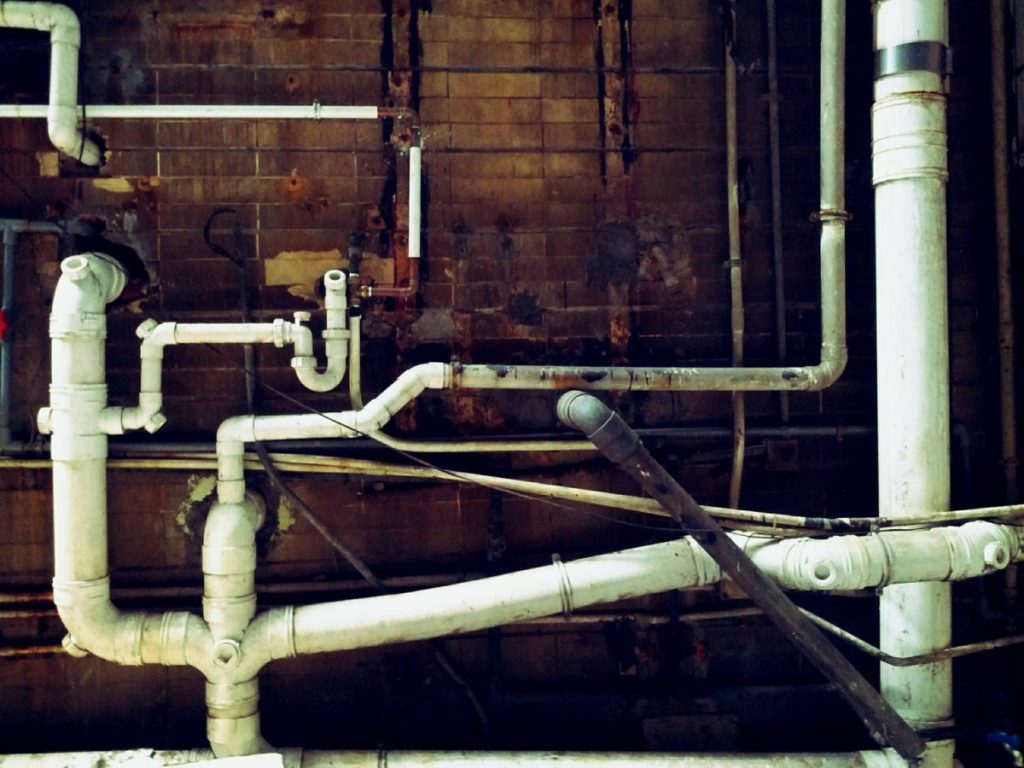To start with, let’s answer the most significant questions in this article. What is a French drain? What does a french drain look like? A French drain is a perforated pipe that fills the trench wrapped in a waterproof fabric and covers it with several layers of stone or gravel.
A French drain is a simple yet effective drainage solution that helps to divert water away from areas where it can cause problems, such as building foundations, gardens, or lawns. It works by providing an easy channel for water to flow through, using gravity to naturally draw water away from problematic areas and disperse it safely.
| Advantage | Description |
| Effective Moisture Control | French drains effectively redirect water away from structures and areas prone to water accumulation, thereby preventing water damage and pooling. |
| Reduces Soil Erosion | By managing surface water flow, French drains help to prevent soil erosion around landscapes and foundations, preserving soil integrity. |
| Low Maintenance | Once installed, French drains require minimal upkeep, making them a convenient and cost-effective solution for long-term moisture management. |
| Versatile Application | Suitable for residential, agricultural, and commercial properties, French drains can be adapted to various landscapes and installation needs. |
| Environmentally Friendly | French drains use natural processes to manage water, making them an environmentally friendly choice for managing excess water without the use of pumps or chemicals. |
| Improves Property Value | Proper drainage systems like French drains can increase property value by protecting the structural integrity of buildings and improving the usability of the land. |
| Prevents Foundation Damage | By keeping the area around a building’s foundation dry, French drains help prevent water-related issues like cracking and settling of the foundation. |
This table showcases the practical and long-term benefits of integrating a French drain into your property’s landscape and infrastructure.
Heavy rain and melting snow can cause water to accumulate in the yard, large areas of mud, and standing water. Also, water can’t run off the yard and can get into the house, causing flooding and water damage. To protect your home’s foundation from permanent damage and prevent flooding, you can install a French drain to redirect the water away from the house. By diverting water from saturated soil, a French drainage system also reduces the amount of standing water in your yard, so your children and pets can enjoy your lawn without worrying about huge puddles.
How does a french drain work? French drainage collects and directs water. A wide perforated pipe in the ground excess water and diverts it away from the affected area. The tube is covered with gravel or stone so that it is not visible and angled downward to allow unobstructed drainage.
Contents
What is a French Drainage System?
Now let’s clarify the following question for readers who are hearing about this device for the first time. What is a french drain system? The drainage system is a set of components for the drainage of water.
|
Aspect |
Description |
| Definition | A French Drainage System is a sub-surface or ground-level drainage method that involves a perforated pipe, typically surrounded by gravel and covered with soil. |
| Components |
|
| Types |
|
| Function | Redirects water away from areas where it can cause damage (e.g., foundations) to safer locations like storm drains or collection pits. |
| Installation Process |
|
| Advantages |
|
| Disadvantages |
|
| Ideal Usage | Recommended for areas prone to water accumulation or with poor natural drainage. Commonly used around buildings, gardens, and in agricultural fields. |
| Lifespan and Maintenance | Typically lasts 15-30 years, depending on materials used and environmental conditions. Maintenance might involve clearing out debris and checking for pipe integrity. |
What are french drains? According to the principle of structure and maintenance, drainage systems are :
- surface – collect rain and meltwater- the element of the design is drainage trays;
- ground – a universal device for groundwater control laid underground;
- double – two types of drainage are installed simultaneously on the site with a complex relief and high groundwater level.
What is french drain on the surface? The surface drainage network serves to collect precipitation. It is a system of channels 50 cm deep, in which trays and gutters are laid. The components of the network are:
- water intakes;
- sand traps;
- plastic pipes;
- drainage trays.
What is a french drainage system in the ground? A large volume of groundwater requires the installation of a ground drainage system. The network of drainage pipes is around the house at a depth of 1.5 m. The trenches have a slope towards the collector. Drainage wells are at the intersection of tubes. Previously, asbestos-cement pipes collect water. These elements had many disadvantages:
- rapid siltation;
- short service life;
- the need to punch holes by yourself.
Modern materials for drainage are much more convenient and efficient. Plastic pipes or drains were with ready perforation, and some were covered with a layer of geotextile. There are two types of products for sale – smooth and corrugated, easily bent at any angle. The presence of stiffeners in the design allows you to evenly distribute the pressure. Among the varieties of pipes, there are:
- single-layer and double-layer;
- products with a filtering shell;
- rigid and flexible.
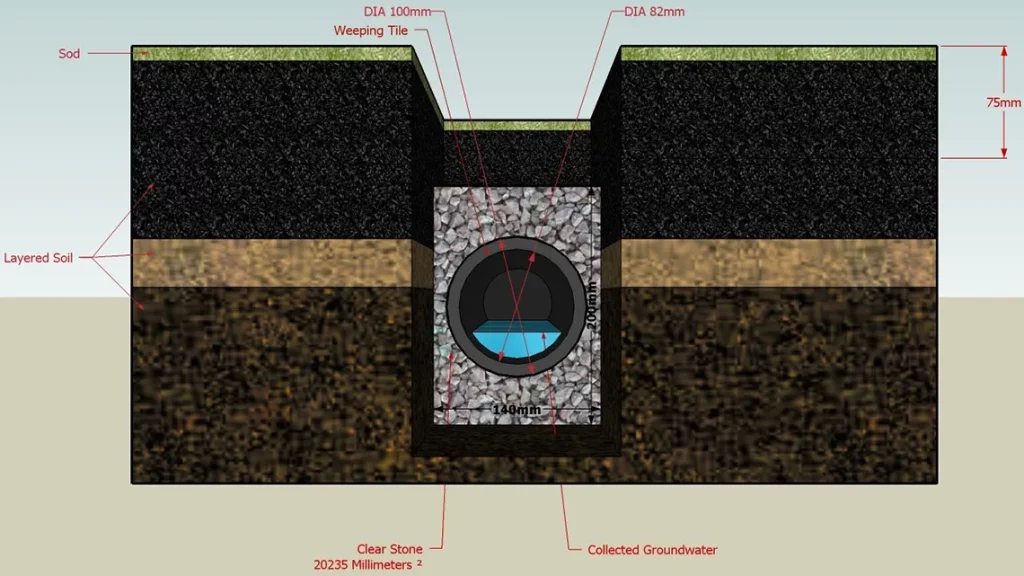
How Does French Drain Work?
How do french drains work? For relocating water from one area to another, a French drainage system consists of a ditch lined with gravel and a perforated pipe that drains water. The gravity diverts this water to the desired location, usually a drainage ditch, sump pump, storm drain, or sewer system.
French drainage provides an easy path for water through the gravel and into the culvert. The perforated pipe needs to be angled downward so gravity can do its job.
Weeping tiles or internal French drainage can also be used to prevent basement flooding and protect the foundation from water damage. Weeping tiles are a type of French drainage and are used to protect the structure from hydrostatic pressure. They are installed around the perimeter of the house to divert water away from the foundation.
When enough sand, clay, or silt enters through the fabric, the gravel space fills the effectiveness of French drainage is low. That’s why most experts say that French drainage is not a long-term solution to your drainage problem: you’ll have to dig it out and reinstall it every 8 to 10 years.
How does french drain work? French drains are incredibly effective because, unlike conventional surface drains, they collect water along the entire length, rather than in one designated area. The force of gravity helps direct the water along a smooth path to the desired discharge point.
Reasons to Install French Drainage System
What is french drainage? French drains can prevent water damage to your property and improve the landscape. What’s more, they can be more effective than piles and even increase the value of your property. If you have such problems, professional drainage installation may be the problem-solving for you.
We offer you the following advantages of installing drains near your home:
- they prevent flooding and reduce the risk of damage to your home;
- long-lasting period of use (30 – 40 years).
- cost-effective;
- french drains can be aesthetically pleasing because the owners cover them with small stones, plants, and sometimes even decorative grates.
Installing French drainage is such a large project, sometimes requiring a permit, so it is usually advisable to call in professionals. Also, before you start trenching, you should call 811 to say you don’t accidentally hit any gas or utility lines under the ground.
Once the area has been marked and cleared for excavation, a trench is dug and lined with landscaping fabric to keep weeds and roots from clogging the pipe. Then an inlet grate is installed at the top of the trench and they begin laying the tubes. They will continue installing the pipes until they reach the drainage point. When the pipes and grate are installed, they will check the drainage to make sure everything is working and backfill the trench with gravel and topsoil.
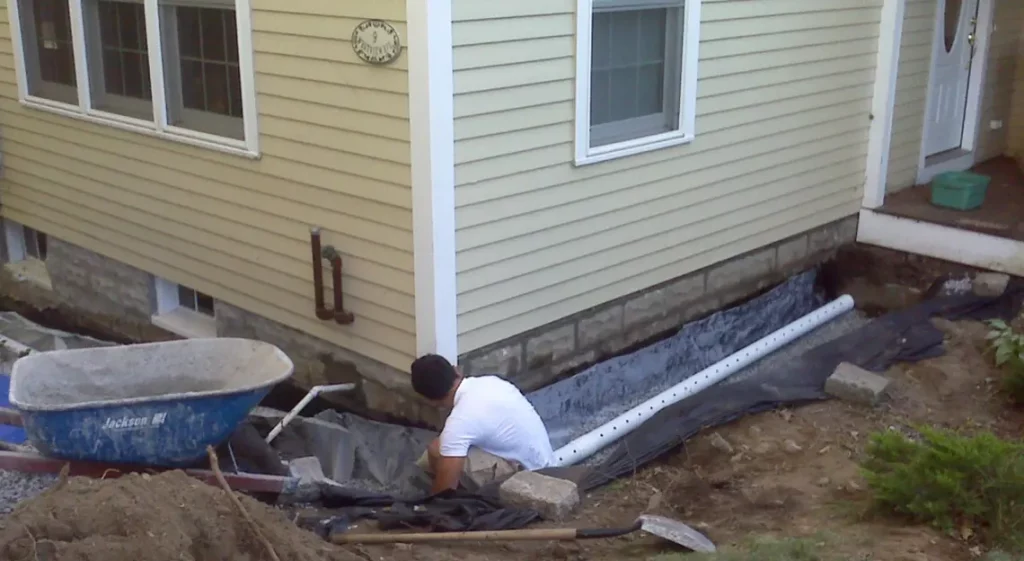
When You Shouldn’t Install a French Drain
French drains can work well on some properties, and foundation waterproofing companies across the country offer them to homeowners more often than almost any other waterproofing system.
The problem is that French drains don’t always work! Here are four specific reasons why they can’t solve your drainage problems:
- They do not work on all types of soil.
Most importantly, French drains do not work in all parts of the country. You may have three types of soil on your property: loose sand soil, medium loam soil (a mixture of sand, silt, and clay), and compacted, heavy clay soil.
Clay soil is dense and does not allow water to pass through easily, so rain accumulates on the surface and runoff slowly seeps into the ground.
French drains work best in mud, from which water drains into a perforated pipe. Because clay soil absorbs and retains moisture, there is much less chance that water will get into the drain than, sandy soil.
If you live in an area with clay soil where it rains often – a French drain would probably be a good way to spend a few thousand dollars.
Even if you have perfect sandy soil for French drainage, you may be out of luck if the site is poorly drained. If the ground is poorly drained, it means that groundwater is close to the surface for one reason or another, so rain and melting snow have little room to soak into the ground before they come back out.
If you live on a property that just doesn’t drain well, water will fill your gutter because it has nowhere to drain. Now you have a very expensive standpipe to collect standing water that will still damage your foundation.
- They require a sufficient slope.
A perforated French drainage pipe must be angled down to some point where it is safe to drain excess water. This is usually a storm drain or a low point on a large lot.
If the pipe does not have a sufficient slope at any point in the line, water will accumulate in the low section. Naturally, if this happens next to the foundation, it can cause serious damage.
Most homeowners don’t encounter this kind of problem with a French drain, but even a minor accumulation of water can render your expensive drainage system useless.
- They can get clogged.
An outside French drain can get clogged, like a sink or toilet flush in your home. Most often, clogs occur after a few years because there is too much dirt or plant material in the filtering material surrounding the drain pipe. Sometimes, a clog can occur within a year of installation if the service company doing the work does not use the right material.
- Someone or something can crush them.
The pipe in French drainage is usually a black corrugated plastic pipe. These pipes are affordable and easy to install because, unlike PVC, they bend easily and do not require many connections.
After the drainage pipe is installed, gravel and dirt are placed on top of it. Since the drain pipe is made of plastic, there is a chance that it will collapse from the weight of the backfill.
Even if it doesn’t collapse right away, over time it can collapse. People walking through the area can squeeze the soil enough to crush the pipe, and some equipment – such as lawnmowers or trucks used for other landscaping jobs – can have enough weight to destroy the tube.
To summarize, we answered the questions: what is a french drain and how does it work? Whether you need them or not is based on your living conditions, needs, and budget.
FAQ about What Is a French Drain and How Does It Work
The materials used to construct a French drain include a perforated pipe, gravel, and a filter fabric. Depending on the specific needs of your business, other materials like sand or geotextile may also be used.
Yes, a French drain can be installed indoors if your business requires it. Interior French drains are commonly used in commercial properties like basements, garages, and storage areas to prevent flooding and water damage.
The cost of installing a French drain in a commercial property depends on several factors, including the size of the property, the type of soil, and the depth of the drain. On average, the cost ranges from $20 to $30 per linear foot.
A French drain should be inspected and cleaned at least once a year to ensure proper function. However, if your business is located in an area with heavy rainfall or other environmental factors that could impact the drain, more frequent maintenance may be necessary.



